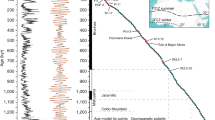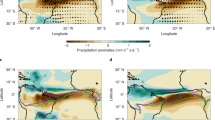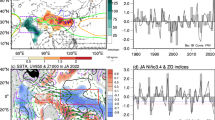Abstract
The Azores High is a persistent atmospheric high-pressure ridge over the North Atlantic surrounded by anticyclonic winds that steer rain-bearing weather systems and modulate the oceanic moisture transport to Europe. The areal extent of the Azores High thereby affects precipitation across western Europe, especially during winter. Here we use observations and ensemble climate model simulations to show that winters with an extremely large Azores High are significantly more common in the industrial era (since ce 1850) than in pre-industrial times, resulting in anomalously dry conditions across the western Mediterranean, including the Iberian Peninsula. Simulations of the past millennium indicate that the industrial-era expansion of the Azores High is unprecedented throughout the past millennium (since ce 850), consistent with precipitation proxy evidence from Portugal. Azores High expansion emerges after ce 1850 and strengthens into the twentieth century, consistent with anthropogenically driven warming.
This is a preview of subscription content, access via your institution
Access options
Access Nature and 54 other Nature Portfolio journals
Get Nature+, our best-value online-access subscription
$29.99 / 30 days
cancel any time
Subscribe to this journal
Receive 12 print issues and online access
$259.00 per year
only $21.58 per issue
Buy this article
- Purchase on Springer Link
- Instant access to full article PDF
Prices may be subject to local taxes which are calculated during checkout




Similar content being viewed by others
Data availability
Observational datasets are publicly accessible at NOAA/OAR/ESRL PSL, Boulder, Colorado, USA, from their website at https://psl.noaa.gov/; and ERA-20C from ECMWF (https://www.ecmwf.int/en/forecasts/datasets/reanalysis-datasets/era-20c). Climate model output is publicly available as follows: CESM LME (https://www.cesm.ucar.edu/projects/community-projects/LME/) is available through Earth System Grid (https://www.earthsystemgrid.org/dataset/ucar.cgd.ccsm4.cesmLME.html), PMIP3 data through https://esgf-node.llnl.gov/search/cmip5/. Stable isotope data in Fig. 3d are available through NCEI at https://www.ncei.noaa.gov/access/paleo-search/study/29392.
Code availability
Code used to perform the analysis presented in this study is provided as part of the replication package. It is available at https://github.com/nathanielcresswellclay/AzoresHighExpansion.
References
Hartmann, D. L. et al. (2013). Observations: Atmosphere and Surface. In Climate Change 2013: The Physical Science Basis. In Fifth Assessment Report of the Intergovernmental Panel on Climate Change. Cambridge University Press, Cambridge, United Kingdom and New York, NY, USA.
Giorgi, F. & Lionello, P. Climate change projections for the Mediterranean region. Glob. Planet. Change 63, 90–104 (2008).
Bindi, M. & Olesen, J. E. The responses of agriculture in Europe to climate change. Regional Environ. Change 11, 151–158 (2011).
Arenas-Castro, S., Gonçalves, J. F., Moreno, M. & Villar, R. Projected climate changes are expected to decrease the suitability and production of olive varieties in southern Spain. Sci. Total Environ. 709, 136161 (2020).
Moriondo, M. et al. Projected shifts of wine regions in response to climate change. Climatic Change 119, 825–839 (2013).
Ayuda, M.-I., Esteban, E., Martín-Retortillo, M. & Pinilla, V. The blue water footprint of the Spanish wine industry: 1930–2015. Water https://doi.org/10.3390/w12071872 (2020).
Webster, P. J. The elementary Hadley Circulation. In The Hadley Circulation: Present, Past and Future (eds Diaz, H. F. & Bradley, R. S.) 9–60 (Springer, 2004).
O’Gorman, P. A. & Muller, C. J. How closely do changes is surface and column water vapor follow Clausius–Clapeyron scaling in climate change simulations. Environ. Res. Lett. 5, 025207 (2010).
D’Agostino, R. & Lionello, P. The atmospheric moisture budget in the Mediterranean: mechanisms for seasonal changes in the Last Glacial Maximum and future warming scenario. Quat. Sci. Rev. 241, 106392 (2020).
Sousa, P. M. et al. North Atlantic integrated water vapor transport—from 850 to 2100 CE: impacts of western European rainfall. J. Clim. 33, 263–279 (2020).
Moberg, A., Sonechkin, D. M., Holmgren, K., Datsenko, N. M. & Karlen, W. Highly variable Northern Hemisphere temperatures reconstructed from low- and high-resolution proxy data. Nature 433, 610–613 (2005).
Li, W., Li, L., Ting, M. & Liu, Y. Intensification of Northern Hemisphere subtropical highs in a warming climate. Nat. Geosci. 5, 830–834 (2012).
He, C. et al. Enhanced or weakened Western North Pacific Subtropical High under global warming? Sci. Rep. https://doi.org/10.1038/srep16771 (2015).
Raible, C. C., Ziv, B., Saaroni, H. & Wild, M. Winter synoptic-scale variability over the Mediterranean Basin under future climate conditions as simulated by the ECHAM5. Clim. Dyn. 35, 473–488 (2010).
D’Agostino, R., Scambiati, A. L., Jungclaus, J. & Lionello, P. Poleward shift of northern subtropics in winter: time of emergence of zonal versus regional signals. Geophys. Res. Lett. 47, e2020GL089325 (2020).
Waugh, D. W. et al. Revisiting the relationship among metrics of tropical expansion. J. Clim. 31, 7565–7581 (2018).
Grise, K. M. et al. Recent tropical expansion: natural variability or forced response? J. Clim. 32, 1551–1571 (2019).
Karnauskas, K. B. & Ummenhofer, C. C. On the dynamics of the Hadley circulation and subtropical drying. Clim. Dyn. 42, 2259–2269 (2014).
Li, W. et al. Changes to the North Atlantic subtropical high and its role in the intensification of summer rainfall variability in the southeastern United States. J. Clim. https://doi.org/10.1175/2010JCLI3829.1 (2011).
Li, W. et al. Impacts of the North Atlantic subtropical high on interannual variation of summertime heat stress over the conterminous United States. Clim. Dyn. 53, 3345–3359 (2019).
Ioannidou, L. & Yau, M. K. A climatology of the Northern Hemisphere winter anticyclones. J. Geophys. Res. Atmospheres 113, D08119 (2008).
Woollings, T., Gregory, J. M., Pinto, J. G., Reyers, M. & Brayshaw, D. J. Response of the North Atlantic storm track to climate change shaped by ocean–atmosphere coupling. Nat. Geosci. 5, 313–317 (2012).
Marshall, J., Johnson, H. & Goodmann, J. A study of the interaction of the North Atlantic oscillation with ocean circulation. J. Clim. 14, 1399–1421 (2001).
Demény, A. et al. (2020). Holocene hydrological changes in Europe and the role of the North Atlantic ocean circulation from a speleothem perspective. Quat. Int. https://doi.org/10.1016/j.quaint.2020.10.061 (2020).
Zappa, G., Ceppi, P. & Shepherd, T. G. Time-evolving sea-surface warming patterns modulate the climate change response of subtropical precipitation over land. Proc. Natl Acad. Sci. USA https://doi.org/10.1073/pnas.1911015117 (2020).
Pepler, A., Dowdy, A. & Hope, P. A global climatology of surface anticyclones, their variability, associated drivers and long-term trends. Clim. Dyn. 52, 5397–5412 (2019).
Hurrell, J. W. & Van Loon, H. Decadal variations in climate associated with the North Atlantic Oscillation. Climatic Change 36, 301–326 (1997).
Trouet, V. et al. Persistent positive North Atlantic Oscillation mode dominated the medieval climate anomaly. Science 324, 78–80 (2009).
Olsen, J., Anderson, N. J. & Knudsen, M. F. Variability of the North Atlantic Oscillation over the past 5,200 years. Nat. Geosci. 5, 808–812 (2012).
Lehner, F., Raible, C. C. & Stocker, T. F. Testing the robustness of a precipitation proxy-based North Atlantic Oscillation reconstruction. Quat. Sci. Rev. 45, 85–94 (2012).
Ortega, P. et al. A model-tested North Atlantic Oscillation reconstruction for the past millennium. Nature 523, 71–74 (2015).
Cook, E. R. et al. A Euro-Mediterranean tree-ring reconstruction of the winter NAO index since 910 CE. Clim. Dyn. 53, 1567–1580 (2019).
Hernández, A. et al. A 2,000-year Bayesian NAO reconstruction from the Iberian Peninsula. Sci. Rep. 10, 14961 (2020).
Visbeck, M. H., Hurrell, J. W., Polvani, L. & Cullen, H. M. The North Atlantic Oscillation: past, present, and future. Proc. Natl Acad. Sci. USA 98, 12876–12877 (2001).
Otto-Bliesner et al. Climate variability and change since 850 CE: an ensemble approach with the Community Earth System Model. Bull. Am. Meteorol. Soc. 97, 735–754 (2015).
Davis, R. E., Hayden, B. P., Gay, D. A., Phillips, W. L. & Jones, G. V. The North Atlantic Subtropical Anticyclone. J. Clim. 10, 728–744 (1997).
Vicente-Serrano, S. M. et al. The NAO impact on droughts in the Mediterranean region. Adv. Glob. Change Res. 46, 23–40 (2011).
Tucker, W. B., Weatherly, J. W., Eppler, D. T., Farmer, L. D. & Bentley, D. L. Evidence for rapid thinning of sea ice in the western Arctic Ocean at the end of the 1980s Greenland. Geophys. Res. Lett. 28, 2851–2854 (2001).
Ben-Gai, T., Bitan, A., Manes, A., Alpert, P. & Kushnir, Y. Temperature and surface pressure anomalies in Israel and the North Atlantic Oscillation. Theor. Appl. Climatol. 69, 171–177 (2001).
Yin, J. H. A consistent poleward shift of the storm tracks in simulations of 21st century climate. Geophys. Res. Lett. 32, L18701 (2005).
Thatcher, D. L. et al. Hydroclimate variability from western Iberia (Portugal) during the Holocene: insights from a composite stalagmite isotope record. Holocene 30, 966–981 (2020).
Alfaro-Sánchez, R. et al. Climatic and volcanic forcing of tropical belt northern boundary over the past 800 years. Nat. Geosci. 11, 933–938 (2018).
Ait Brahim, Y. et al. Multi-decadal to centennial hydro-climate variability and linkage to solar forcing in the Western Mediterranean during the last 1000 years. Sci. Rep. 8, 17446 (2018).
Allan, R. & Ansell, T. A new globally complete monthly historical gridded mean sea level pressure dataset (HadSLP2): 1850-–2004. J. Clim. 19, 5816–5842 (2006).
Schneider, U. et al. GPCC Full Data Reanalysis Version 6.0 at 0.5°: Monthly Land-Surface Precipitation from Rain-Gauges Built on GTS-Based and Historic Data (GPCC, 2011); https://doi.org/10.5676/DWD_GPCC/FD_M_V7_050
Compo, G. P. et al. The twentieth century reanalysis project. Q. J. R. Meteorol. Soc. 137, 1–28 (2011).
Poli, P. et al. ERA-20C: an atmospheric reanalysis of the twentieth century. J. Clim. 29, 4083–4097 (2016).
Compo, G. P., Whitaker, J. S. & Sardeshmukh, P. D. Feasibility of a 100-year reanalysis using only surface pressure data. Bull. Am. Meteorol. Soc. 87, 175–190 (2006).
Hurrell, J. W. et al. The Community Earth System Model: a framework for collaborative research. Bull. Am. Meteorol. Soc. 94, 1339–1360 (2013).
Kwon, Y. O. et al. North Atlantic winter eddy-driven jet and atmospheric blocking variability in the Community Earth System Model version 1 Large Ensemble simulations. Clim. Dyn. 51, 3275–3289 (2018).
Landrum, L. et al. Last millennium climate and its variability in CCSM4. J. Clim. 26, 1085–1111 (2013).
Xin, X. G., Wu, T. W. & Zhang, J. Introduction of CMIP5 experiments carried out with the climate system models of Beijing climate center. Adv. Clim. Change Res. 4, 41–49 (2013).
Gent, P. R. et al. The Community Climate System Model version 4. J. Clim. 24, 4973–4991 (2011).
Dufresne, J. L. et al. Climate change projections using the IPSL-CM5 Earth system model: from CMIP3 to CMIP5. Clim. Dyn. 40, 2123–2165 (2013).
Sueyoshi, T. et al. Set-up of the PMIP3 paleoclimate experiments conducted using an Earth system model, MIROC-ESM. Geosci. Model Dev. 6, 819–836 (2013).
Watanabe, S. et al. MIROC-ESM 2010: model description and basic results of CMIP5-20c3m experiments. Geosci. Model Dev. 4, 845–872 (2011).
Giorgetta, M. A. et al. Climate and carbon cycle changes from 1850 to 2100 in MPI-ESM simulations for the Coupled Model Intercomparison Project phase 5. J. Adv. Model. Earth Syst. https://doi.org/10.1002/jame.20038 (2013).
Taylor, K. E., Stouffer, R. J. & Meehl, G. A. An overview of CMIP5 and the experiment design. Bull. Am. Meteorol. Soc. 93, 485–498 (2012).
Zappa, G., Shaffrey, L. & Hodges, K. The ability of CMIP5 models to simulate North Atlantic extratropical cyclones. J. Clim. 26, 5379–5396 (2013).
Colle, B. A. et al. Historical evaluation and future prediction of eastern North American and Western Atlantic extratropical cyclones in the CMIP5 models during the cool season. J. Clim. 26, 6882–6903 (2013).
Kwon, Y. O., Seo, H., Ummenhofer, C. C. & Joyce, T. M. Impact of multidecadal variability in Atlantic SST on winter atmospheric blocking. J. Clim. 33, 867–892 (2020).
Verburg, P. The need to correct for the Suess effect in the application of δ13C in sediment of autotrophic Lake Tanganyika, as a productivity proxy in the Anthropocene. J. Paleolimnol. 37, 591–602 (2007).
Railsback, L. B. et al. A multi-proxy climate record from a northwestern Botswana stalagmite suggesting wetness late in the Little Ice Age (1810–1820 CE) and drying thereafter in response to changing migration of the tropical rain belt or ITCZ. Palaeogeogr. Palaeoclimatol. Palaeoecol. 506, 139–153 (2018).
Acknowledgements
Use of the following datasets is gratefully acknowledged: Global Precipitation Climatology Center dataset by the German Weather Service (DWD), HadSLP2 from the UK Hadley Centre and NOAA–CIRES Twentieth Century Reanalysis, all provided by the NOAA/OAR/ESRL PSL, Boulder, Colorado, USA, from their website at https://psl.noaa.gov/; ERA-20C from ECMWF. Support for the Twentieth Century Reanalysis Project version 2c dataset is provided by the US Department of Energy, Office of Science Biological and Environmental Research (BER) and by the National Oceanic and Atmospheric Administration Climate Program Office. We acknowledge the CESM1(CAM5) Last Millennium Ensemble Community Project and supercomputing resources provided by NSF/CISL/Yellowstone, as well as the World Climate Research Programme’s Working Group on Coupled Modelling, which is responsible for CMIP, and we thank the climate modelling groups for producing and making available their model output, with specific contributions from Beijing Climate Center’s Climate System Modelling Division, the National Center for Atmospheric Research, Institut Pierre Simon Laplace’s Climate Modelling Center, Max-Planck-Institut fur Meteorologie’s Modelling Division and the Atmosphere and Ocean Research Institute at the University of Tokyo. CMIP5 model output was provided by the WHOI CMIP5 Community Storage Server via their website: http://cmip5.whoi.edu/. Cave research at Buraca Gloriosa conducted with the assistance of Associação de Estudos Subterrâneos e Defesa do Ambiente and Jonathan Haws. This work was supported by the US National Science Foundation (grants: AGS-1804528 to A.D.W.; AGS-1804635 to R.F.D.; AGS-1804132 to C.C.U.), Cornell College (to R.F.D.) and the Ocean Climate Change Institute and James E. and Barbara V. Moltz Fellowship for Climate-Related Research at WHOI (to C.C.U.).
Author information
Authors and Affiliations
Contributions
N.C.-C. and C.C.U. conceived the study and designed the analyses. N.C.-C. conducted all the analyses. N.C.-C. and C.C.U. wrote the manuscript. D.L.T., A.D.W. and R.F.D. provided feedback on the analyses and manuscript. Y.A. and V.J.P. provided feedback on the manuscript.
Corresponding author
Ethics declarations
Competing interests
The authors declare no competing interests.
Peer review
Peer review information
Nature Geoscience thanks Pedro Sousa and the other, anonymous, reviewer(s) for their contribution to the peer review of this work. Primary Handling Editor: James Super, in collaboration with the Nature Geoscience team.
Additional information
Publisher’s note Springer Nature remains neutral with regard to jurisdictional claims in published maps and institutional affiliations.
Extended data
Extended Data Fig. 1 Azores High Area in PMIP3 Models.
(a,c,e,g,i) Timeseries of Azores High Area (AHA) during the PMIP3 last millennium (grey) and historical (light red) simulations. Extremely large events are indicated as red triangles. Thick red line represents the number of extreme winters in the 100-year period surrounding each year. (b,d,f,h,j) Distribution of AHA during the last millennium (grey) and historical (red) simulations. Each row is calculated using output from the model indicated on the left. For more information on models see Methods: PMIP3 Models.
Extended Data Fig. 2 Extremely Large Azores High Area in PMIP3 Models.
(a) The number of winters with extremely large Azores High in the 100-year period surrounding each year for PMIP3 last millennium (grey) and historical (red) simulations. The Multi Model Ensemble average is shown for the last millennium (thick black) and historical (thick red) simulations. (b) The results of our Monte Carlo test for significance of extremely large Azores High winters (see Methods: Monte Carlo Validation) for the Multi Model Ensemble. The red vertical line shows the number of extremely large Azores High winters that occurred in the last 100 years of the historical simulation; this is significant to p = 0.02 (see Methods: Monte Carlo Validation). The models and simulations used are discussed in Methods: PMIP3 Models.
Extended Data Fig. 3 Hydroclimate during winters with extremely large Azores High in observations and models.
(a,c,e) Wintertime anomalies in precipitation (contours) and moisture transport in g kg–1 m s–1 (vectors) during winters with extremely large Azores High. (b,d,f) Wintertime anomalies in sea level pressure (contours) and moisture transport (vectors) during winters with extremely large Azores High. Each row was calculated using the dataset indicated to the left. Precipitation in (a) and (c) is based on the GPCC dataset. The multi-model ensemble was calculated using PMIP3 models interpolated onto a regular 2° by 2°grid.
Extended Data Fig. 4 Hydroclimate during winters with extremely large Azores High in individual models.
(a,c,e,g,i) Wintertime anomalies in precipitation (contours) and moisture transport in g kg–1 m s–1(vectors) during winters with extremely large Azores High. (b,d,f,h,j) Anomalies in sea level pressure (contours) and moisture transport (vectors) during winters with extremely large Azores High. Each row was calculated using output from the models indicated to the left. For information on models and simulations see Extended Data Table 2.
Rights and permissions
About this article
Cite this article
Cresswell-Clay, N., Ummenhofer, C.C., Thatcher, D.L. et al. Twentieth-century Azores High expansion unprecedented in the past 1,200 years. Nat. Geosci. 15, 548–553 (2022). https://doi.org/10.1038/s41561-022-00971-w
Received:
Accepted:
Published:
Issue Date:
DOI: https://doi.org/10.1038/s41561-022-00971-w
This article is cited by
-
Surface ozone trends reversal for June and December in an Atlantic natural coastal environment
Environmental Science and Pollution Research (2024)
-
Iberian hydroclimate variability and the Azores High during the last 1200 years: evidence from proxy records and climate model simulations
Climate Dynamics (2023)
-
Opposite trends of sea-breeze speeds and gusts in Eastern Spain, 1961–2019
Climate Dynamics (2023)
-
Overstating the effects of anthropogenic climate change? A critical assessment of attribution methods in climate science
European Journal for Philosophy of Science (2023)
-
North Atlantic Oscillation contributes to the subpolar North Atlantic cooling in the past century
Climate Dynamics (2023)



